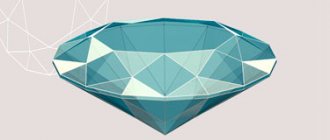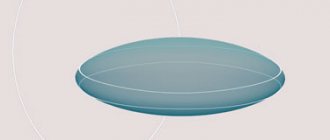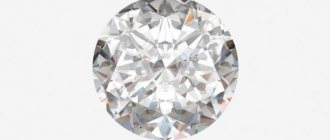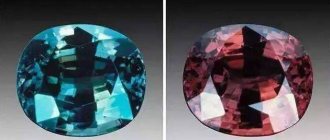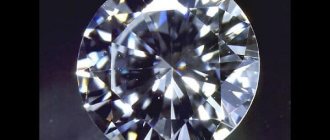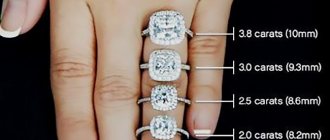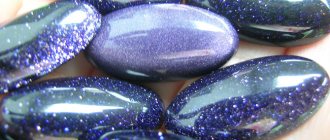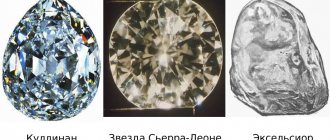Stones are cut to give them a certain shape, to emphasize the shine and play of light. A high-quality cut prevents rays from passing through - they are refracted in the edges of transparent and translucent stones and come back out. First, a scheme is created and thought through, taking into account the shape of the stone, the number, size and location of the edges and angles between the edges. The stones are then cut and polished.
There are about 250 varieties of cuts in jewelry. They depend not only on the taste preferences of jewelers, but also on the physical and optical characteristics of the stones. During the cutting process, it is important to preserve the weight of the stone and its natural advantages. Cutting can be divided into three large groups: smooth , faceted and mixed .
Smooth cut
Although formally it is classified as cutting, in essence it is polishing. The stone processed in this way has no edges, only a polished surface.
Cabochon (from the French caboche - “head” or “nail with a wide and round head”) is the most famous type of smooth cut. The cabochon is considered one of the first, and therefore the oldest, cuts. Honed stone usually has a flat bottom and a smooth, convex dome. Most often it is made in the shape of a circle or oval, although other shapes are also found: rectangle, rhombus, heart, drop, boat, crescent.
Cabochon cutting is used for opaque and translucent stones, as well as for stones with various optical effects (asterism, iridescence, opalescence, cat's eye). This is how jade, turquoise, amber, malachite, lapis lazuli, serpentine, onyx, opal, tugtupite, and sometimes sapphires, rubies and other stones are processed. This cutting method is not very complicated, and the quality of the source material does not play a big role.
Different types of cabochons are used for different tasks and stones. Opaque stones with a colored surface are cut into a single cabochon, which has a flat base and a convex top. For stones with internal defects, the shape of a double (lentil) cabochon, in which both sides are convex, is suitable. Dark stones are often cut into hollow cabochons with a concave base. There is also a tall cabochon with a very convex top and a flat one that looks like a frozen drop of candle wax.
Ball is another smooth cut option.
Semi-precious and ornamental stones are processed in this way: aventurine, agate, amethyst, quartz, malachite, onyx, jasper.
Emerald
A rectangle with octagonal beveled edges - from 3 to 6 on each side - is an ideal shape for emeralds and any jewelry where the green gem is used as the dominant insert. The only requirement for the stone is that it must be of maximum purity, without internal cracks, darkening and traces of obvious laboratory refining, because the entire interior will be visible in the light.
Faceted cut
The most diverse type of cut is faceted or beveled (from the French facette - “edge”). As the name suggests, this treatment creates many edges on the surface of the stone. Faceted cutting is used when working with transparent stones: it brings out their shine, enhances color and emphasizes light effects.
To understand the features of different facet cutting options, you need to understand the anatomy of a faceted stone.
Scheme 1: structure of a cut stone
The upper and lower parts of the stone are separated by a thin belt - a girdle. Usually the frame is fixed on it. The upper part, located above the girdle, is called the crown. There is a platform on it - a flat top face, the largest face of the stone. The lower part, located under the girdle, is called the pavilion. And the point of convergence of the edges of the pavilion at the very bottom is a culet; it can be in the form of a spike, a small horizontal edge or a line.
The faceted cut is divided into two types: classic or round brilliant , and fancy .
Why is it necessary to treat precious stones?
Gem cutting is a complex process during which gemstones, both precious and semi-precious, are given the desired shape.
The master’s task is to take into account all the nuances of the original specimen, its structural features and composition. By taking these subtleties into account, you can achieve an amazing result when the surface of an inconspicuous pebble becomes smooth and clear edges begin to appear on it.
Different shapes of stone cuts contribute to the appearance of bright light reflections. Their iridescence gives a stunning shine, and the crystal begins to “play.” Light hitting the edges is refracted, shimmering with all shades of the spectrum, and we can observe unusual light effects.
The types of cutting of precious stones can be different, but the main thing that is taken into account when carrying out this type of jewelry work is the type of edges and the shape that is given to the stone.
There are many options for cutting stones, but any of them involves a very long and difficult process of creating a crystal of an ideal shape. Using various cutting tools, from 30 to 240 facets are created on a gemstone.
Called facets, they must be perfectly smooth and located at the correct angle.
Faceted: round diamond
The round brilliant cut is the most common form of cutting for diamonds and other clear stones with strong light dispersion.
The pioneers of the round shape are considered to be the Americans Henry Morse and Charles Field, who in the 1870s created a steam engine for processing diamonds.
The round cut best demonstrates the brilliance and play of light in the stone and minimizes the risk of external damage. A diamond sparkles brightest if the exact proportions of the pavilion's edges are met - they are the ones who ensure complete internal reflection of light. The main disadvantage of the round cut is the significant loss of weight of the nugget: after processing, up to 60% of the original weight can be lost.
The classic or full brilliant cut consists of 57 facets. There are 33 facets on the crown and 24 facets on the pavilion. First of all, this cut is used for large diamonds weighing over 1 carat. The main role here is played by proportions, symmetry and surface quality. The standard of a classic cut is considered to be the “ideal diamond,” the parameters of which were calculated by mathematician Marcel Tolkowsky in 1919.
The simplified brilliant cut consists of 33 or 17 facets. It is used when processing small and medium-sized stones: 33 facets for stones weighing up to 0.99 carats, 17 facets for “diamond chips” weighing up to 0.29 carats. Diamonds, rhodolites, amethysts, sapphires, rubies, peridots, topazes and many other stones are processed in this way.
Photo 1: classic or full diamond cut, the author of this and other photographs is Dmitry Stolyarevich
Types of round cuts that have more than 57 facets are called diamond modifications. These are, for example, the Belgian Highlight (73 facets), King (86 facets) and Magna (102 facets) developed in New York, or the Royal Cut (154 facets).
Trillion
The youngest method of processing natural gems has not even celebrated its 40th anniversary - it was patented by an Amsterdam jewelry house in the mid-80s. As you might guess, the prefix three- in the word trillion means the texture of a triangle, along which the edges are alternately applied. They can be equilateral or isosceles, the main thing is to ensure the refraction of light and disintegration into that same priceless rainbow spectrum.
Faceted: fantasy. Step varieties
With this cut, the edges are arranged parallel and above each other, like steps. The wide upper platform is made in the form of a polygon, and the side faces are in the form of trapezoids or isosceles triangles.
The step cut does not cause brilliant shine, but rather emphasizes the color of the stone. Therefore, it is used for transparent stones of “medium color tones”: a high cut enhances the color, a low cut weakens it.
The table or table cut is one of the simplest step cuts. Usually it is a flat stone with a large platform: the crown consists of five sides, the pavilion - of four. A variation can be considered the Mirror cut with a very large platform and a shallow pavilion. The table is used mainly for semi-precious and ornamental stones, which are often used in signet rings.
Baguette is an elongated version of the Table, cut in the shape of a rectangle. Shapes such as Trapezium and Square (Care) are often classified as varieties of Baguette.
The modern version of this cut appeared in the early 20th century. Its name comes from the French. bague – Until the 17th century, this word meant precious stones in general. The Baguette has 14 sides, and there are also 24-sided versions. Technically it is quite simple, but due to the openness of the edges it requires high purity of the stone. This is how small side stones in jewelry are mainly cut: diamonds, rubies, emeralds, topazes.
Other quadrangles - Rhombus, Kite, Epaulet, Barrel - are considered varieties of Baguette. They are distinguished by the inclination of the corners and the curvature of the sides. Pentagon and Hexagon are also distinguished as independent forms.
Emerald (Emerald) or Octagon - a step cut with an octagonal shape of the stone. It consists of 58 or 65 edges and looks like a Baguette, but the corners here are not sharp, but beveled.
Modern Emerald standards were adopted in the 1940s - initially this cut was intended specifically for emeralds, but over time, sapphires, tourmalines, beryls, and other stones began to be cut this way. Here, too, high purity and transparency of the stone is required, otherwise imperfections will be visible to the naked eye. But the light that falls on the surface is reflected in wide and bright flashes. In terms of cost and complexity, this is one of the most affordable cuts.
Asscher is an octagonal cut, which is made in the shape of a square and has characteristics similar to Emerald. It was developed in 1902 by the famous Dutch jeweler Joseph Asscher, but it gained popularity only in the 1920s. The original version has 58 edges, and its modification, the Royal Asscher, has 74 edges.
Photo 2: emerald cut
Photo 3: Asscher cut
Baguette
The ancestor of the emerald appeared exactly one hundred years ago, when, after the First World War, the Art Deco style emerged in European culture, which became a hymn to geometric minimalism. The style, on the one hand, resembles the famous bakery product, and on the other, it is a kind of picture frame in miniature - it is not surprising that in a professional environment they are also called baguettes. The cut is good for men's signets and women's jewelry of a strict style.
Faceted: fantasy. Wedge varieties
Wedge cut shapes are often considered variations of the round brilliant cut. In this case, many edges in the form of wedges are applied to the surface, which well reveal the color of the stone and enliven the play of light in it.
Oval – this cut compares favorably with round by maintaining the weight of the stone. It was created in the 1960s by jeweler Lazar Kaplan. Oval-cut stones usually have 57 facets, although the number may vary. The elongated shape allows you to create the illusion of a larger stone; it looks especially advantageous in rings. The oval cut is used mainly for large transparent stones - aquamarines, amethysts, sapphires, topaz.
Marquis (Marquise) is an oval with pointed ends, similar to a boat. This cut was created in France in the mid-18th century, and according to legend, it was dedicated to the smile of the Marquise de Pompadour. The marquise also has 57 facets and is characterized by a slight loss in the weight of the nugget: if the stone is initially oblong, up to 80% can be preserved. This is how diamonds, amethysts, emeralds, and rubies are cut. The Shuttle cut is considered a variation of the Marquise - it has a narrower upper platform and slightly fewer facets.
Photo 3: oval cut
Photo 5: marquise cut
Pear – this cut visually resembles a drop: one end is rounded, the other is pointed. It is sometimes considered a hybrid of the round brilliant cut and the marquise cut. The smooth platform is also made in the shape of a drop, there are usually 57 wedge faces. Such a stone should have clear symmetry at the point of narrowing, since this is where the play of light is concentrated.
Aquamarines, amethysts, and topazes are cut in the shape of a Pear. The Pandelok cut is a variation of the Pear, but its pavilion is deeper and rounder.
Briolette, Drop, Olive (Olive) - varieties of elongated teardrop shape. Unlike Grusha, they have neither a platform nor a girdle. The surfaces of Briolette and Olive are completely covered with wedges, only the shape of the Olive resembles an ellipse with cut ends. In the Drop, the narrow upper part is formed by long edges extended downwards, and the rounded lower part is formed by small wedges. Stones cut in this way are mainly used as pendants.
In elongated Oval, Marquise, and Pear cuts, if the proportions and symmetry are disturbed, the optical effect of a “bow tie” may appear: a dark spot in the center of the table.
Photo 5: pear cut
The Princess is a rectangular wedge cut and is the second most popular cut for diamonds. It was created in the 1980s by jeweler Bezalel Ambar - he branded the original version with 49 facets under the name Quadrillion. The princess has square outlines and sharp corners, and the deep pavilion, where the play of light is concentrated, ends in a spike. The 58 facets create a brilliance that rivals round diamonds, but retains about 80% of the stone after cutting.
Flanders is a modification of the Princess, which has 61 sides. It was also invented in the 1980s, named after the Belgian region of Flanders. Features cut corners and very complex symmetry, so the cutting process takes three times longer than creating a round diamond.
Photo 6: princess cut
Antique (Antique) or Cushion (Cushion) - this cut has existed for more than a hundred years and at one time was almost as popular as round brilliant diamonds are today. The shape of the Cushion (English cushion - “pillow”) really resembles a pillow. The stone has rounded corners, 72 sides, and can be square or slightly elongated. This is how diamonds, amethysts, sapphires, emeralds, rubies, quartz and its varieties are cut. By the way, the cut received its other name - Antique - in recognition of its historical roots: its predecessor is considered to be the Old Mine Cut of the 18th century.
Trilliant (Trillian, Trillion) is a triangular wedge cut created by the Asscher brothers at the beginning of the 20th century. The corners of the stone can be sharp, beveled or rounded; some options have a pronounced triangular area, some do not. The classic Trilliant has 43 facets, but modern versions can have 50 facets or more. This cut is well suited for light stones: diamond, aquamarine, beryl, white sapphire. Some jewelers use it to lighten dark stones - tanzanite, amethyst, rhodolite. Varieties of the Trilliant can be considered the Shield and Troidia cuts, in which the sides are slightly curved outward.
The heart is one of the most complex and expensive wedge cut shapes. It is often used in exclusive jewelry. In principle, it resembles a Pear, but splits on the rounded side, taking the shape of a heart. The stone is usually equal in length and width, and consists of 59 facets - their number may vary depending on the original size of the stone. This is how rubies, amethysts, topazes, garnets, and sometimes colored diamonds are cut.
Ball or Sphere is a rather rare type of wedge cut, which has 120 facets or more. Despite the fact that a stone processed in this way will not sparkle very brightly, the cutting itself is extremely labor-intensive and requires high skill.
Photo 7: heart cut
Also worth noting is the collection of polygonal “floral” cuts (Fire Rose, Sunflower, Dahlia, Calendula, Zinnia), which were created by the famous jeweler Gabi Tolkowsky, nephew of the creator of the “ideal diamond”. They are designed specifically for rough diamonds over 0.25 carats and are based on unusual angular parameters. Russian experts have developed the Happy decagonal cut, which has 81 facets. Visually, it is very similar to a round diamond, but, like many other fancy options, it has less weight loss from the stone.
Oval
With the advancement of technology and the advent of electric machines in the mid-20th century, the improved oval cut was born. She didn't just add a wedge-shaped fin surface that maximizes light refraction from the surface of the crystal. Thanks to the elongated texture, precious rings with such an insert visually lengthen the fingers, and pendants or earrings are so impressive that they are guaranteed to attract all the attention.
Princess
The princess cut is a “pumped up” version of a square with at least 16 edges, and they can be located both from the center and from the edges of the outer contour. Its highlight is the mirror symmetry of the corners, which can create a cross-shaped or star-shaped reflection. There are practical advantages - no matter how complex the master jeweler’s idea may be, the specific arrangement of the facets can significantly save the amount of stone removed.
Interesting fact: It was the princess that formed the basis of the most commercially successful Tiffany cut, which since the middle of the last century has become the international standard for engagement rings. According to the American brand, a diamond in such jewelry must have at least 50 facets that can shimmer at the slightest movement of a woman’s hand.
Jewelry examples
The “baguette” cut shape is given to stones for making so-called eternity rings, earrings, necklaces, and bracelets. The baguette cut opened up a new range of possibilities for linear jewelry design. Jewelry with diamonds of this cut are presented in the MUZ Flaming Ice collection.
History knows many examples when the brightest beauties of Hollywood were given jewelry with baguette-cut stones. For example, the wedding gift from Prince Rainier III of Monaco to his beloved Grace Kelly was a Cartier diamond three-tier necklace. The platinum jewelry is complemented with colorless round and baguette-cut diamonds weighing a total of 64 carats. Later, a copy of this necklace, specially created by the house of Cartier, shone on the neck of Nicole Kidman, who played the Princess of Monaco in the biopic.
On the finger of another legendary blonde, Marilyn Monroe, her second husband Joe DiMaggio put an “eternity ring” with baguette-cut diamonds.
Heart
Perhaps the most original and romantic of all forms, because the heart is an internationally recognized symbol of love and reverent feelings for a person. It is not simple, according to the classical standard it has at least 57 edges, hence the excessive requirements for the mass of the workpiece. However, it is “heart” inserts that are most often used in exclusive designer products - the exquisite, unique result is worth any effort.
